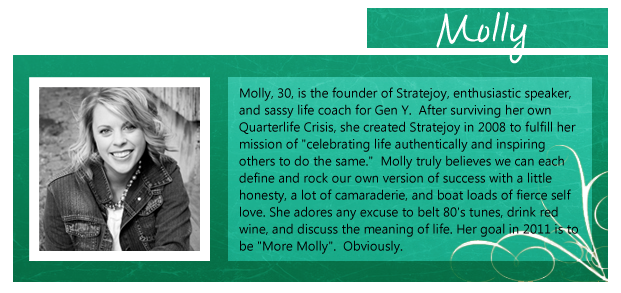Wondering what I'm up to right now? Come hang with me on Instagram!
How to Become an Optimist
Click here to share ‘How to Be an Optimist’ with your friends on Twitter!
It’s been a week since I started this adventure.
I haven’t felt this excited about my work in a LONG time! I think it’s the combination of reading the Season 5 Blogger applications, all the re-reading I’ve been doing on positive psychology, and my commitment to sharing my personal process with you. Ideas are flowing. To do lists are being conquered. My long-term vision of Stratejoy is starting to peek around the clouds of doubt that had been hovering lately.
Hurrah! I’m back! I know just one week of actively engaging in my life isn’t going to be enough however. I’m going to have to keep putting in the “happiness work” and continue to expand my adventures. I do feel that it’s off to a great start though! It’s so affirming to have early success on a project or goal to keep you actively involved, eh?
I’m in Seattle right now, having taught a workshop for workshop here on Saturday for women soldiers based on my post “8 Strategies to Improve Your Quality of Life“. It was all about intentional happiness and specific strategies you can try on daily basis. I was a little nervous to teach for the US Army (Could I wear my sparkly sandals? What if I unknowingly offended someone with my liberal views? Would they see being happy/fulfilled as a silly goal?) but the women I met were just (amazing, dedicated) women. They had fears and dreams and pride in their accomplishments just like all of us.
Duh. I don’t know why I was so nervous!
We had a great morning and one of the pieces that most resonated with me was our lively discussion on cultivating optimism. Being positive can often be seen as naivety or simply “sticking your head in the sand” especially when the real word feels so big and scary. In the throes of natural disasters, continuing high unemployment, and leadership that seems to run in circles, who wants to look on the bright side?
In actuality, optimism is incredibly good for YOU. It increases job performance, creativity, ability to weather stress, health, and self esteem. Negative events don’t hold us down as long. Positive events confirm our belief in the good life. It may not be able to change the events of the world, but it does help each of us navigate our world with a lighter step and more belief that our actions can make a difference. Being optimistic can be amazingly self-fulfilling.
Optimism can be used in how you talk to yourself in the face of adversity, explain past events, and think about the future. Before your read on, wanna see where you may fall on the different facets of optimism/pessimism scale? Here’s the best free version of the Martin Seligman’s Learned Optimism test that I can find
online: ONLINE QUIZ.
Though we tend to have a natural level of optimism/pessimism, learning an optimistic approach to life is totally possible. And that’s where my adventures are taking me next…
 Make Bad Things Less Personal and Pervasive
Make Bad Things Less Personal and Pervasive
Most people would think of me an optimist, yes? It’s something about the bubbly personality and level of excitement I’m capable of showing. It’s a very loud positivity, I know. Positivity is one of my measured strengths, so yes, I do function as an optimist in a many situations.
But not all… And that’s where this Step 2 comes in.
A little background! (Make sure you take the quiz before you read this if you’re going to take it at all!)
Optimism can be looked at via 3 different scales of explanatory styles.
- Permanence
- Pervasiveness
- Personalization
When something negative happens in their life, pessimists tend to describe it as “lasting forever” (permanence), “spreading into all areas of their life” (pervasiveness) and “completely their fault” (personalization). If they get dumped, the story they tell themselves is, “I’ll never find anyone else and will always be alone. My whole life is falling apart because my relationship ended. I’m not good enough and I did everything wrong.” When something great happens in life, pessimists take the opposite side of explanation! The great event will be temporary (lack of permanence), only reflect one part of their life (lack of pervasiveness), and didn’t have anything to do with their effort, talent, or strengths (lack of personalization).
Optimists take the other side of explanation in both kind of events. When something great happens in their life like getting a raise, optimists will say, “This is amazing. All my work effort is paying off and they could tell I really rocked my last assignment (personalization). This is the first raise of many. I’m sure I’ve been marked for the fast track and can look forward to more quick growth (permanence). This is going to make so many things easier (pervasiveness).” On the flip side, when something bad happens it had to do with external factors or others (lack of personalization), isn’t going to last forever (lack of permanence) and won’t affect other parts of their life (lack of pervasiveness).
Woo! Following me, sunshine?
I score very high on all three scales in how I explain positive events in my life, as well as very low on permanence when bad things happen to me. So far, so good.
Unfortunately, I struggle with personalization and pervasiveness when bad events occur. I take negative events very personally and then let them spread into all corners of my life (I personally failed at selling out my new course, and thus suck at being a business owner, and thus suck at everything in life). This tendency can paralyze me when crappy things happen. I suddenly started doubting my worth and letting it poison my confidence in other parts of my life that have nothing do with the crappy event.
Eeek! I’m tackling this tendency because bad things will always happen, that’s just life! I want to practice new ways of processing the events, so I can move on more quickly and with less damage to my self-esteem.
My challenge…
- Become aware of when something bad/negative occurs.
- Tune into how I’m responding to it, including my self talk and how I share the story with others.
- Practice seeing the other side of Personalization (Is this really my fault? What other factors may have played into this? Is it really and truly “bad” or are my expectations out of whack?)
- Practice seeing the other side of Pervasiveness (Will this really affect other areas of my life? How might this be an isolated event? What are the great things that are happening elsewhere in my world?)
This part of Adventures in Flourishing is going to be harder to measure and track than my other challenges, because it’s a mental pattern and not an external habit to stop/develop. But I’m up to it!!
What about you? Do you have a distinct piece of Cultivating Optimism you want to tackle?
For those of you participating in this entire series, here are the other posts to remind you what we are up to:
Adventures in Flourishing
The Well-Being Theory and My Happiness Score
ENGAGEMENT
- Stop Drinking: 8 days Sober. Note to self, Going to an Amos Lee concert at the Chateau St Michelle Winery when you aren’t drinking wine (but still love wine) is tortuous. Only the gravelly sexy soul-infused voice of Amos and your supportive sister saved you. Please don’t test your willpower again for a while.
- Stop Hulu.com: 5 workdays TV free.
- Write in the Morning: 5 days complete. I missed Friday morning with a house guest sleeping in my office and an early flight. Back on it this morning and experienced a bit of flow! Yay!
POSITIVE EMOTION
- Make Bad Things Less Personal and Pervasive: I’m ready to tackle some mental gymnastics when an external event starts making me feel less than… Bring it on big bad world!
You might also like...
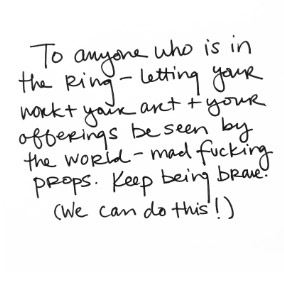
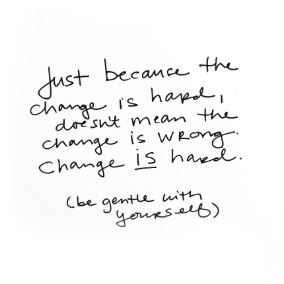
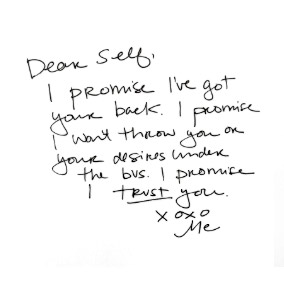

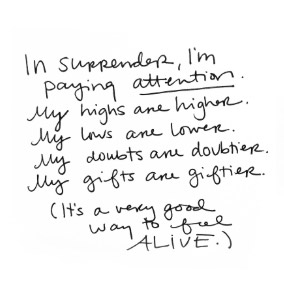
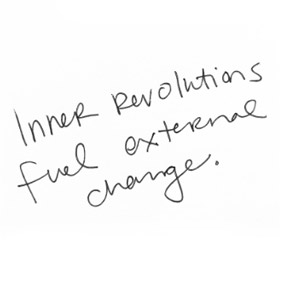

Real Talk
In real time
Inner truth + outer alignment = unapologetic joy
Get my weekly-ish love notes to help you reclaim an intimate, honest + joyful relationship with yourself, for the good of all.


